Impact of Communication & Language Barriers on Construction Safety
VerifiedAdded on 2023/06/14
|63
|12847
|313
Project
AI Summary
This research investigates the impact of communication and language barriers on migrant workers in the Singaporean construction industry, focusing on how these barriers contribute to accidents. It identifies less knowledge of English, cultural diversity, and status differences as key factors hindering effective communication and comprehension of safety guidelines. The study uses both quantitative and qualitative data, including surveys and case studies, to analyze the relationship between communication barriers and safety incidents. The findings suggest that implementing effective training programs for language and safety, along with establishing employee feedback mechanisms, can significantly reduce accidents. The research concludes by recommending strategies to overcome these barriers and improve safety outcomes for migrant workers in the construction sector.
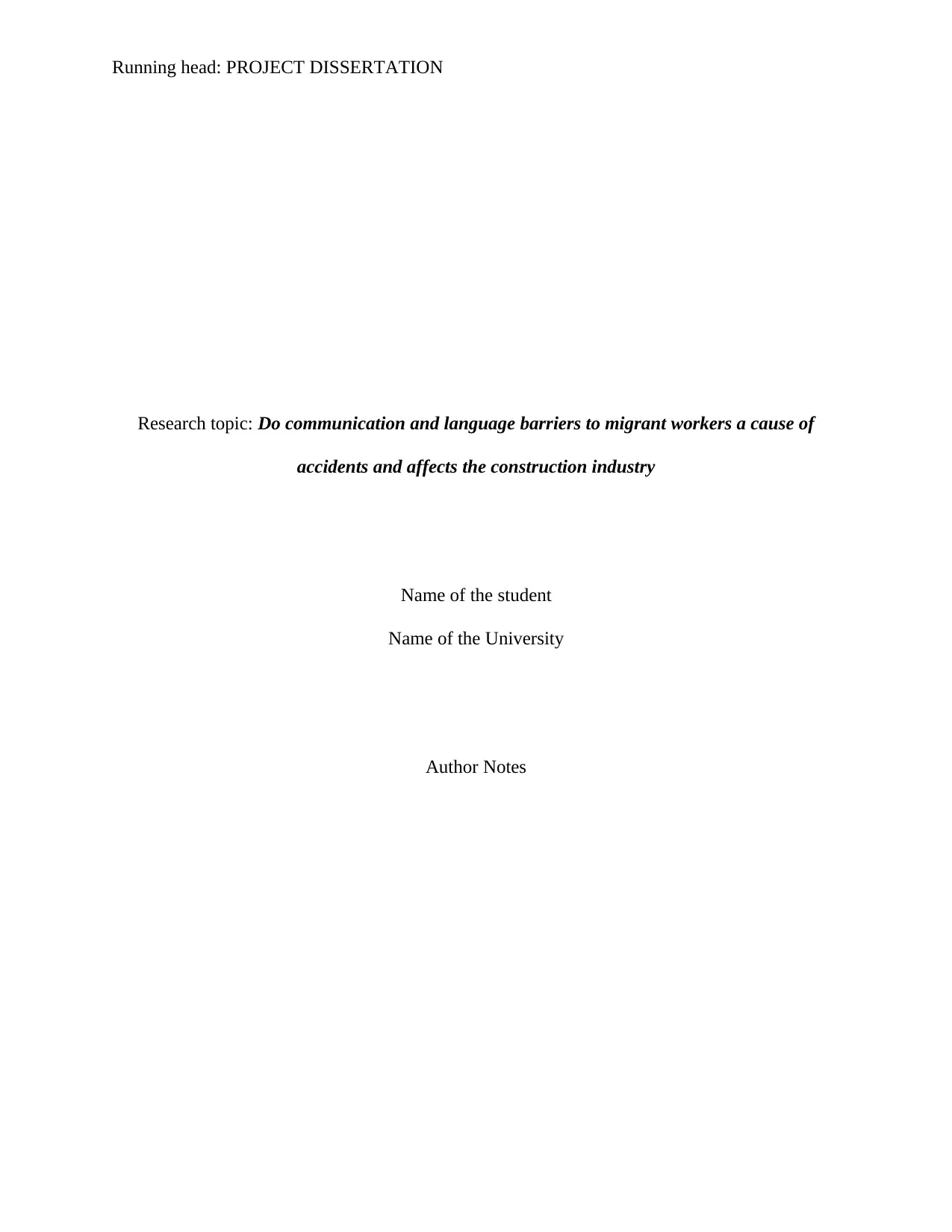
Running head: PROJECT DISSERTATION
Research topic: Do communication and language barriers to migrant workers a cause of
accidents and affects the construction industry
Name of the student
Name of the University
Author Notes
Research topic: Do communication and language barriers to migrant workers a cause of
accidents and affects the construction industry
Name of the student
Name of the University
Author Notes
Paraphrase This Document
Need a fresh take? Get an instant paraphrase of this document with our AI Paraphraser

1PROJECT DISSERTATION
Acknowledgement
I am thankful that I have been given the opportunity for conducting the research on the topic of
“Do communication and language barriers to migrant workers a cause of accidents and affects
the construction industry”. I want to express heartiest thanks to my principal Mr./Mrs./Ms.
______________________________________________ for giving me the privilege to be the
part of this university, _______________________ University.
My special thanks to my Mentor Mr./Mrs./Ms.
______________________________________________ for guiding me from the initial stage of
the project to is final completion.
My friends and family also plays a crucial role for providing me unlimited encouragement and
motivation unless which I will not be able to complete the dissertation project within time.
Acknowledgement
I am thankful that I have been given the opportunity for conducting the research on the topic of
“Do communication and language barriers to migrant workers a cause of accidents and affects
the construction industry”. I want to express heartiest thanks to my principal Mr./Mrs./Ms.
______________________________________________ for giving me the privilege to be the
part of this university, _______________________ University.
My special thanks to my Mentor Mr./Mrs./Ms.
______________________________________________ for guiding me from the initial stage of
the project to is final completion.
My friends and family also plays a crucial role for providing me unlimited encouragement and
motivation unless which I will not be able to complete the dissertation project within time.
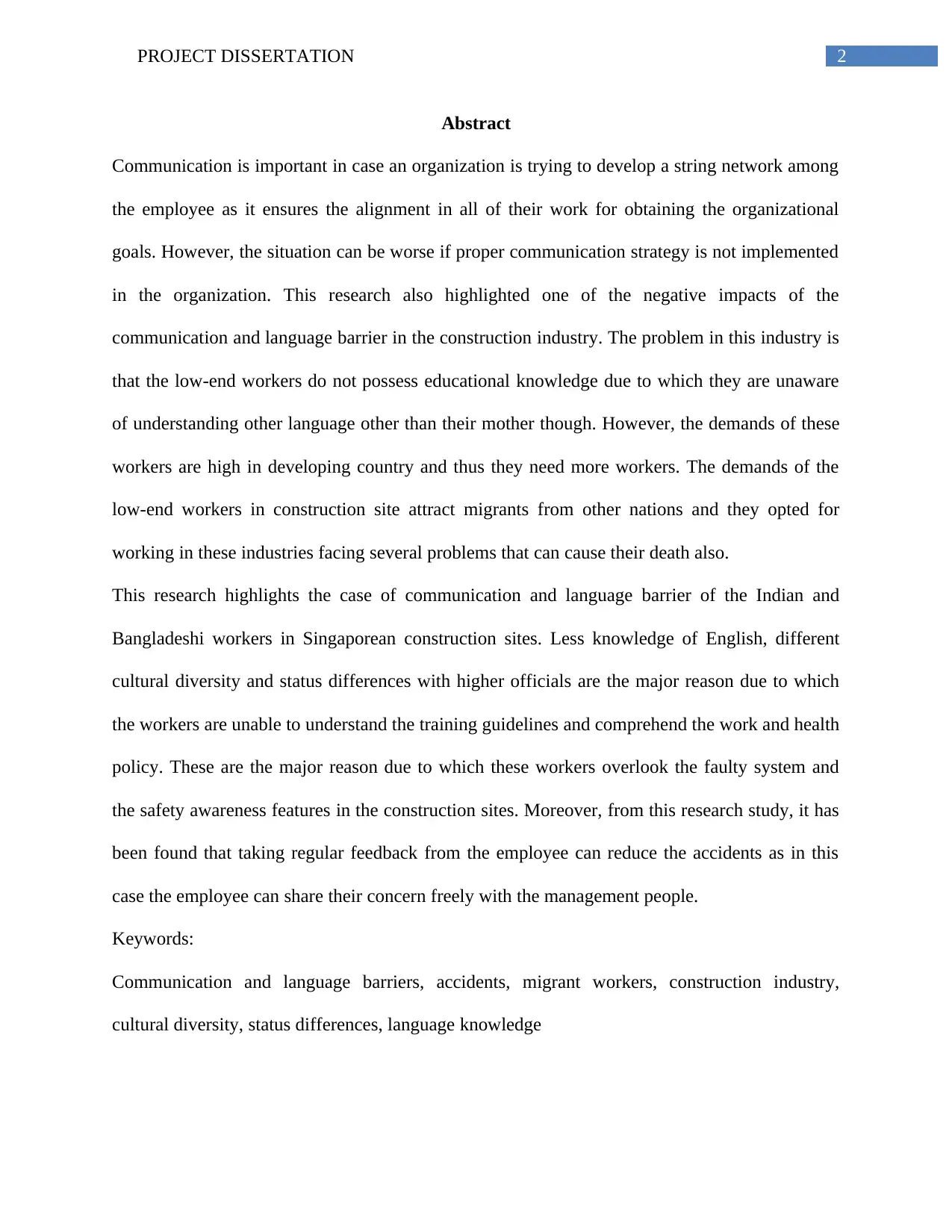
2PROJECT DISSERTATION
Abstract
Communication is important in case an organization is trying to develop a string network among
the employee as it ensures the alignment in all of their work for obtaining the organizational
goals. However, the situation can be worse if proper communication strategy is not implemented
in the organization. This research also highlighted one of the negative impacts of the
communication and language barrier in the construction industry. The problem in this industry is
that the low-end workers do not possess educational knowledge due to which they are unaware
of understanding other language other than their mother though. However, the demands of these
workers are high in developing country and thus they need more workers. The demands of the
low-end workers in construction site attract migrants from other nations and they opted for
working in these industries facing several problems that can cause their death also.
This research highlights the case of communication and language barrier of the Indian and
Bangladeshi workers in Singaporean construction sites. Less knowledge of English, different
cultural diversity and status differences with higher officials are the major reason due to which
the workers are unable to understand the training guidelines and comprehend the work and health
policy. These are the major reason due to which these workers overlook the faulty system and
the safety awareness features in the construction sites. Moreover, from this research study, it has
been found that taking regular feedback from the employee can reduce the accidents as in this
case the employee can share their concern freely with the management people.
Keywords:
Communication and language barriers, accidents, migrant workers, construction industry,
cultural diversity, status differences, language knowledge
Abstract
Communication is important in case an organization is trying to develop a string network among
the employee as it ensures the alignment in all of their work for obtaining the organizational
goals. However, the situation can be worse if proper communication strategy is not implemented
in the organization. This research also highlighted one of the negative impacts of the
communication and language barrier in the construction industry. The problem in this industry is
that the low-end workers do not possess educational knowledge due to which they are unaware
of understanding other language other than their mother though. However, the demands of these
workers are high in developing country and thus they need more workers. The demands of the
low-end workers in construction site attract migrants from other nations and they opted for
working in these industries facing several problems that can cause their death also.
This research highlights the case of communication and language barrier of the Indian and
Bangladeshi workers in Singaporean construction sites. Less knowledge of English, different
cultural diversity and status differences with higher officials are the major reason due to which
the workers are unable to understand the training guidelines and comprehend the work and health
policy. These are the major reason due to which these workers overlook the faulty system and
the safety awareness features in the construction sites. Moreover, from this research study, it has
been found that taking regular feedback from the employee can reduce the accidents as in this
case the employee can share their concern freely with the management people.
Keywords:
Communication and language barriers, accidents, migrant workers, construction industry,
cultural diversity, status differences, language knowledge
⊘ This is a preview!⊘
Do you want full access?
Subscribe today to unlock all pages.

Trusted by 1+ million students worldwide
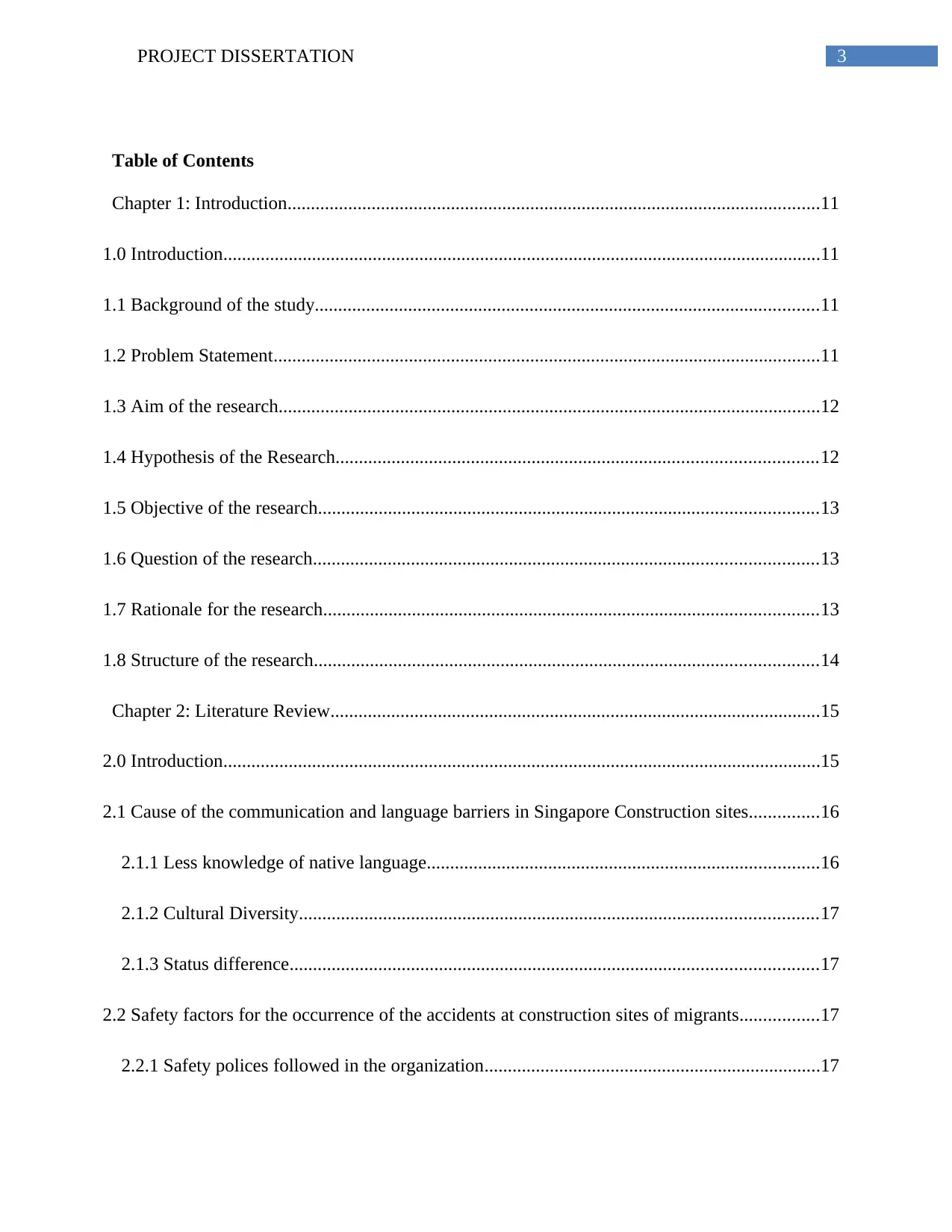
3PROJECT DISSERTATION
Table of Contents
Chapter 1: Introduction..................................................................................................................11
1.0 Introduction................................................................................................................................11
1.1 Background of the study............................................................................................................11
1.2 Problem Statement.....................................................................................................................11
1.3 Aim of the research....................................................................................................................12
1.4 Hypothesis of the Research.......................................................................................................12
1.5 Objective of the research...........................................................................................................13
1.6 Question of the research............................................................................................................13
1.7 Rationale for the research..........................................................................................................13
1.8 Structure of the research............................................................................................................14
Chapter 2: Literature Review.........................................................................................................15
2.0 Introduction................................................................................................................................15
2.1 Cause of the communication and language barriers in Singapore Construction sites...............16
2.1.1 Less knowledge of native language....................................................................................16
2.1.2 Cultural Diversity...............................................................................................................17
2.1.3 Status difference.................................................................................................................17
2.2 Safety factors for the occurrence of the accidents at construction sites of migrants.................17
2.2.1 Safety polices followed in the organization........................................................................17
Table of Contents
Chapter 1: Introduction..................................................................................................................11
1.0 Introduction................................................................................................................................11
1.1 Background of the study............................................................................................................11
1.2 Problem Statement.....................................................................................................................11
1.3 Aim of the research....................................................................................................................12
1.4 Hypothesis of the Research.......................................................................................................12
1.5 Objective of the research...........................................................................................................13
1.6 Question of the research............................................................................................................13
1.7 Rationale for the research..........................................................................................................13
1.8 Structure of the research............................................................................................................14
Chapter 2: Literature Review.........................................................................................................15
2.0 Introduction................................................................................................................................15
2.1 Cause of the communication and language barriers in Singapore Construction sites...............16
2.1.1 Less knowledge of native language....................................................................................16
2.1.2 Cultural Diversity...............................................................................................................17
2.1.3 Status difference.................................................................................................................17
2.2 Safety factors for the occurrence of the accidents at construction sites of migrants.................17
2.2.1 Safety polices followed in the organization........................................................................17
Paraphrase This Document
Need a fresh take? Get an instant paraphrase of this document with our AI Paraphraser
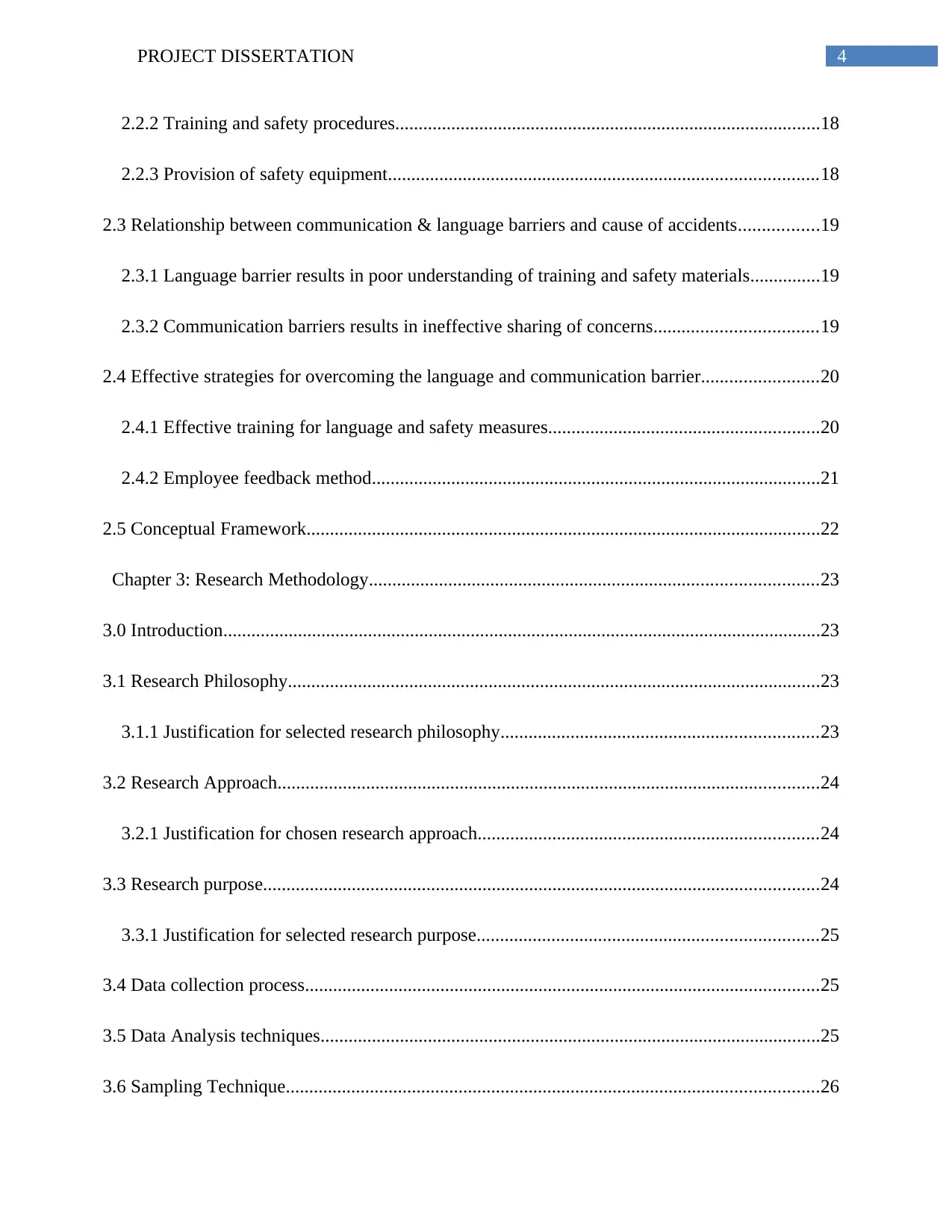
4PROJECT DISSERTATION
2.2.2 Training and safety procedures...........................................................................................18
2.2.3 Provision of safety equipment............................................................................................18
2.3 Relationship between communication & language barriers and cause of accidents.................19
2.3.1 Language barrier results in poor understanding of training and safety materials...............19
2.3.2 Communication barriers results in ineffective sharing of concerns...................................19
2.4 Effective strategies for overcoming the language and communication barrier.........................20
2.4.1 Effective training for language and safety measures..........................................................20
2.4.2 Employee feedback method................................................................................................21
2.5 Conceptual Framework..............................................................................................................22
Chapter 3: Research Methodology................................................................................................23
3.0 Introduction................................................................................................................................23
3.1 Research Philosophy..................................................................................................................23
3.1.1 Justification for selected research philosophy....................................................................23
3.2 Research Approach....................................................................................................................24
3.2.1 Justification for chosen research approach.........................................................................24
3.3 Research purpose.......................................................................................................................24
3.3.1 Justification for selected research purpose.........................................................................25
3.4 Data collection process..............................................................................................................25
3.5 Data Analysis techniques...........................................................................................................25
3.6 Sampling Technique..................................................................................................................26
2.2.2 Training and safety procedures...........................................................................................18
2.2.3 Provision of safety equipment............................................................................................18
2.3 Relationship between communication & language barriers and cause of accidents.................19
2.3.1 Language barrier results in poor understanding of training and safety materials...............19
2.3.2 Communication barriers results in ineffective sharing of concerns...................................19
2.4 Effective strategies for overcoming the language and communication barrier.........................20
2.4.1 Effective training for language and safety measures..........................................................20
2.4.2 Employee feedback method................................................................................................21
2.5 Conceptual Framework..............................................................................................................22
Chapter 3: Research Methodology................................................................................................23
3.0 Introduction................................................................................................................................23
3.1 Research Philosophy..................................................................................................................23
3.1.1 Justification for selected research philosophy....................................................................23
3.2 Research Approach....................................................................................................................24
3.2.1 Justification for chosen research approach.........................................................................24
3.3 Research purpose.......................................................................................................................24
3.3.1 Justification for selected research purpose.........................................................................25
3.4 Data collection process..............................................................................................................25
3.5 Data Analysis techniques...........................................................................................................25
3.6 Sampling Technique..................................................................................................................26
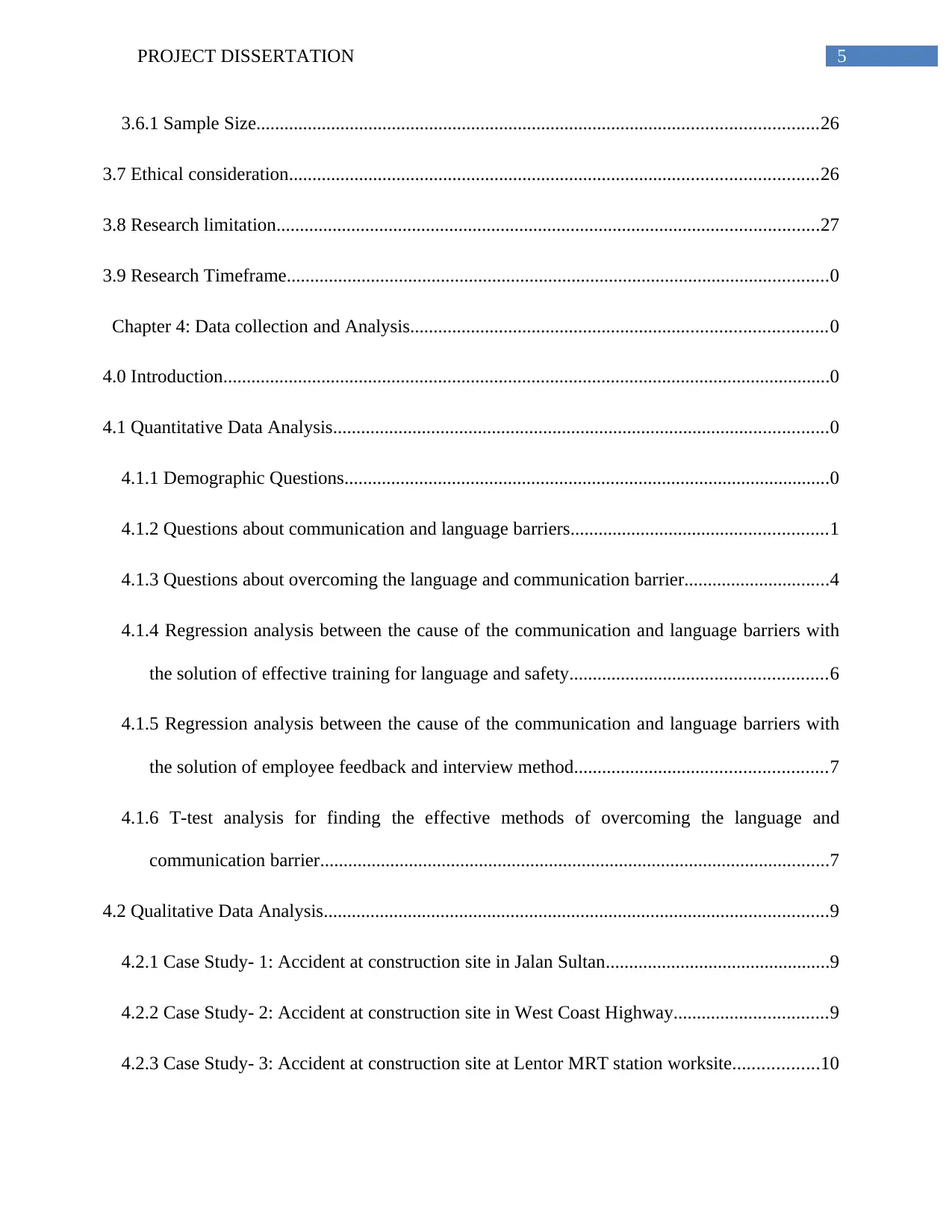
5PROJECT DISSERTATION
3.6.1 Sample Size........................................................................................................................26
3.7 Ethical consideration.................................................................................................................26
3.8 Research limitation....................................................................................................................27
3.9 Research Timeframe....................................................................................................................0
Chapter 4: Data collection and Analysis.........................................................................................0
4.0 Introduction..................................................................................................................................0
4.1 Quantitative Data Analysis..........................................................................................................0
4.1.1 Demographic Questions........................................................................................................0
4.1.2 Questions about communication and language barriers.......................................................1
4.1.3 Questions about overcoming the language and communication barrier...............................4
4.1.4 Regression analysis between the cause of the communication and language barriers with
the solution of effective training for language and safety.......................................................6
4.1.5 Regression analysis between the cause of the communication and language barriers with
the solution of employee feedback and interview method......................................................7
4.1.6 T-test analysis for finding the effective methods of overcoming the language and
communication barrier.............................................................................................................7
4.2 Qualitative Data Analysis............................................................................................................9
4.2.1 Case Study- 1: Accident at construction site in Jalan Sultan................................................9
4.2.2 Case Study- 2: Accident at construction site in West Coast Highway.................................9
4.2.3 Case Study- 3: Accident at construction site at Lentor MRT station worksite..................10
3.6.1 Sample Size........................................................................................................................26
3.7 Ethical consideration.................................................................................................................26
3.8 Research limitation....................................................................................................................27
3.9 Research Timeframe....................................................................................................................0
Chapter 4: Data collection and Analysis.........................................................................................0
4.0 Introduction..................................................................................................................................0
4.1 Quantitative Data Analysis..........................................................................................................0
4.1.1 Demographic Questions........................................................................................................0
4.1.2 Questions about communication and language barriers.......................................................1
4.1.3 Questions about overcoming the language and communication barrier...............................4
4.1.4 Regression analysis between the cause of the communication and language barriers with
the solution of effective training for language and safety.......................................................6
4.1.5 Regression analysis between the cause of the communication and language barriers with
the solution of employee feedback and interview method......................................................7
4.1.6 T-test analysis for finding the effective methods of overcoming the language and
communication barrier.............................................................................................................7
4.2 Qualitative Data Analysis............................................................................................................9
4.2.1 Case Study- 1: Accident at construction site in Jalan Sultan................................................9
4.2.2 Case Study- 2: Accident at construction site in West Coast Highway.................................9
4.2.3 Case Study- 3: Accident at construction site at Lentor MRT station worksite..................10
⊘ This is a preview!⊘
Do you want full access?
Subscribe today to unlock all pages.

Trusted by 1+ million students worldwide
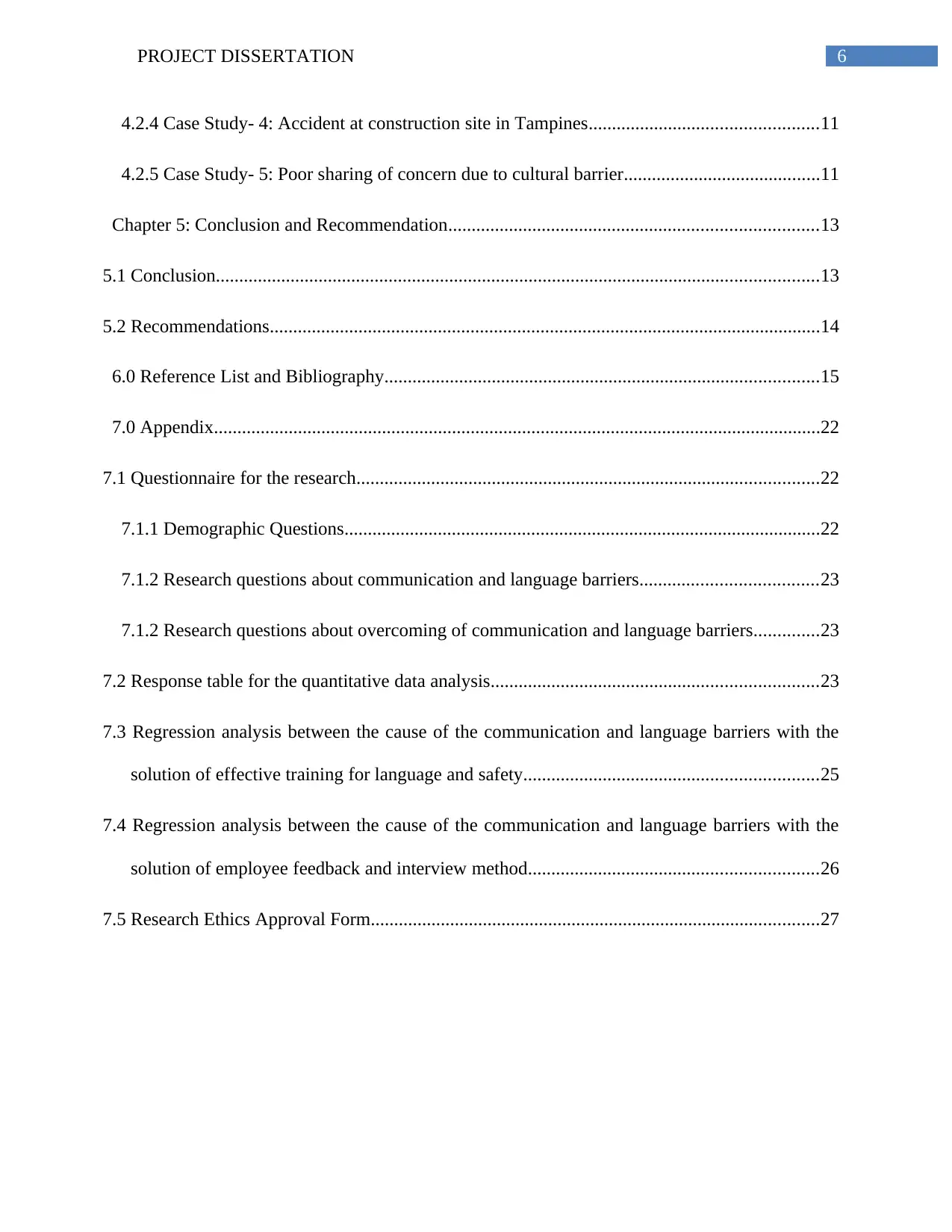
6PROJECT DISSERTATION
4.2.4 Case Study- 4: Accident at construction site in Tampines.................................................11
4.2.5 Case Study- 5: Poor sharing of concern due to cultural barrier..........................................11
Chapter 5: Conclusion and Recommendation...............................................................................13
5.1 Conclusion.................................................................................................................................13
5.2 Recommendations......................................................................................................................14
6.0 Reference List and Bibliography.............................................................................................15
7.0 Appendix..................................................................................................................................22
7.1 Questionnaire for the research...................................................................................................22
7.1.1 Demographic Questions......................................................................................................22
7.1.2 Research questions about communication and language barriers......................................23
7.1.2 Research questions about overcoming of communication and language barriers..............23
7.2 Response table for the quantitative data analysis......................................................................23
7.3 Regression analysis between the cause of the communication and language barriers with the
solution of effective training for language and safety...............................................................25
7.4 Regression analysis between the cause of the communication and language barriers with the
solution of employee feedback and interview method..............................................................26
7.5 Research Ethics Approval Form................................................................................................27
4.2.4 Case Study- 4: Accident at construction site in Tampines.................................................11
4.2.5 Case Study- 5: Poor sharing of concern due to cultural barrier..........................................11
Chapter 5: Conclusion and Recommendation...............................................................................13
5.1 Conclusion.................................................................................................................................13
5.2 Recommendations......................................................................................................................14
6.0 Reference List and Bibliography.............................................................................................15
7.0 Appendix..................................................................................................................................22
7.1 Questionnaire for the research...................................................................................................22
7.1.1 Demographic Questions......................................................................................................22
7.1.2 Research questions about communication and language barriers......................................23
7.1.2 Research questions about overcoming of communication and language barriers..............23
7.2 Response table for the quantitative data analysis......................................................................23
7.3 Regression analysis between the cause of the communication and language barriers with the
solution of effective training for language and safety...............................................................25
7.4 Regression analysis between the cause of the communication and language barriers with the
solution of employee feedback and interview method..............................................................26
7.5 Research Ethics Approval Form................................................................................................27
Paraphrase This Document
Need a fresh take? Get an instant paraphrase of this document with our AI Paraphraser
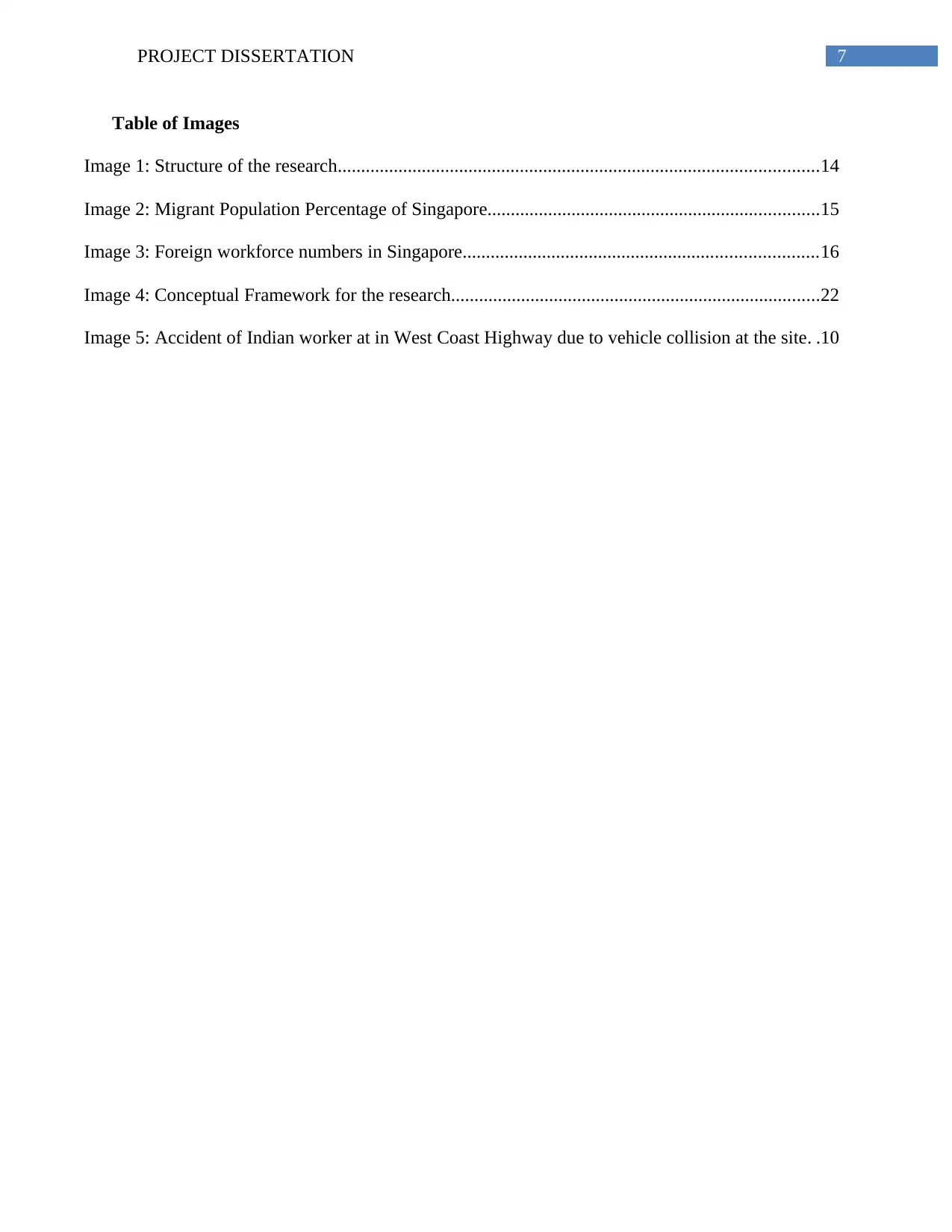
7PROJECT DISSERTATION
Table of Images
Image 1: Structure of the research.......................................................................................................14
Image 2: Migrant Population Percentage of Singapore.......................................................................15
Image 3: Foreign workforce numbers in Singapore............................................................................16
Image 4: Conceptual Framework for the research...............................................................................22
Image 5: Accident of Indian worker at in West Coast Highway due to vehicle collision at the site. .10
Table of Images
Image 1: Structure of the research.......................................................................................................14
Image 2: Migrant Population Percentage of Singapore.......................................................................15
Image 3: Foreign workforce numbers in Singapore............................................................................16
Image 4: Conceptual Framework for the research...............................................................................22
Image 5: Accident of Indian worker at in West Coast Highway due to vehicle collision at the site. .10
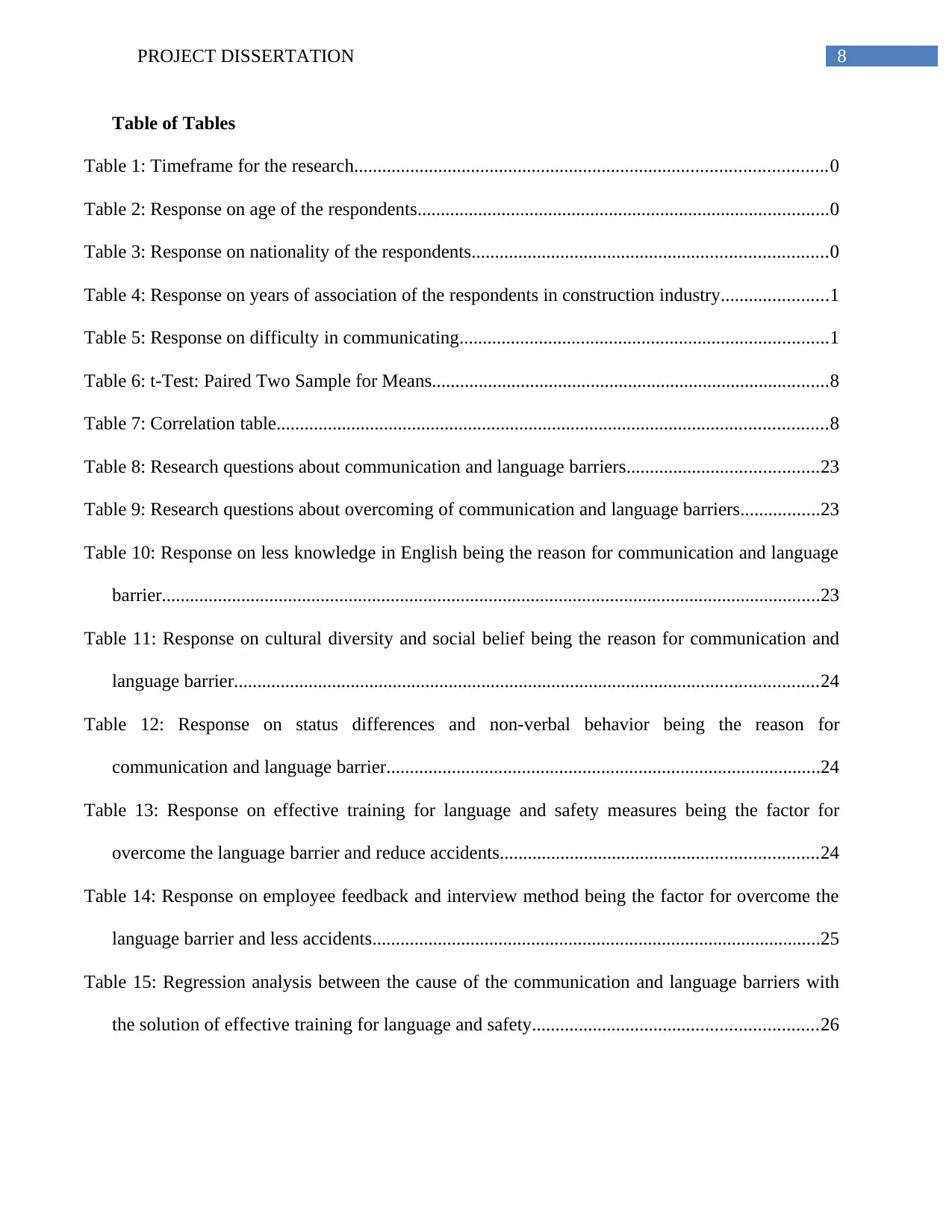
8PROJECT DISSERTATION
Table of Tables
Table 1: Timeframe for the research.....................................................................................................0
Table 2: Response on age of the respondents........................................................................................0
Table 3: Response on nationality of the respondents............................................................................0
Table 4: Response on years of association of the respondents in construction industry.......................1
Table 5: Response on difficulty in communicating...............................................................................1
Table 6: t-Test: Paired Two Sample for Means.....................................................................................8
Table 7: Correlation table......................................................................................................................8
Table 8: Research questions about communication and language barriers.........................................23
Table 9: Research questions about overcoming of communication and language barriers.................23
Table 10: Response on less knowledge in English being the reason for communication and language
barrier.............................................................................................................................................23
Table 11: Response on cultural diversity and social belief being the reason for communication and
language barrier.............................................................................................................................24
Table 12: Response on status differences and non-verbal behavior being the reason for
communication and language barrier.............................................................................................24
Table 13: Response on effective training for language and safety measures being the factor for
overcome the language barrier and reduce accidents....................................................................24
Table 14: Response on employee feedback and interview method being the factor for overcome the
language barrier and less accidents................................................................................................25
Table 15: Regression analysis between the cause of the communication and language barriers with
the solution of effective training for language and safety.............................................................26
Table of Tables
Table 1: Timeframe for the research.....................................................................................................0
Table 2: Response on age of the respondents........................................................................................0
Table 3: Response on nationality of the respondents............................................................................0
Table 4: Response on years of association of the respondents in construction industry.......................1
Table 5: Response on difficulty in communicating...............................................................................1
Table 6: t-Test: Paired Two Sample for Means.....................................................................................8
Table 7: Correlation table......................................................................................................................8
Table 8: Research questions about communication and language barriers.........................................23
Table 9: Research questions about overcoming of communication and language barriers.................23
Table 10: Response on less knowledge in English being the reason for communication and language
barrier.............................................................................................................................................23
Table 11: Response on cultural diversity and social belief being the reason for communication and
language barrier.............................................................................................................................24
Table 12: Response on status differences and non-verbal behavior being the reason for
communication and language barrier.............................................................................................24
Table 13: Response on effective training for language and safety measures being the factor for
overcome the language barrier and reduce accidents....................................................................24
Table 14: Response on employee feedback and interview method being the factor for overcome the
language barrier and less accidents................................................................................................25
Table 15: Regression analysis between the cause of the communication and language barriers with
the solution of effective training for language and safety.............................................................26
⊘ This is a preview!⊘
Do you want full access?
Subscribe today to unlock all pages.

Trusted by 1+ million students worldwide

9PROJECT DISSERTATION
Table 16: Regression analysis between the cause of the communication and language barriers with
the solution of employee feedback and interview method............................................................26
Table 16: Regression analysis between the cause of the communication and language barriers with
the solution of employee feedback and interview method............................................................26
Paraphrase This Document
Need a fresh take? Get an instant paraphrase of this document with our AI Paraphraser
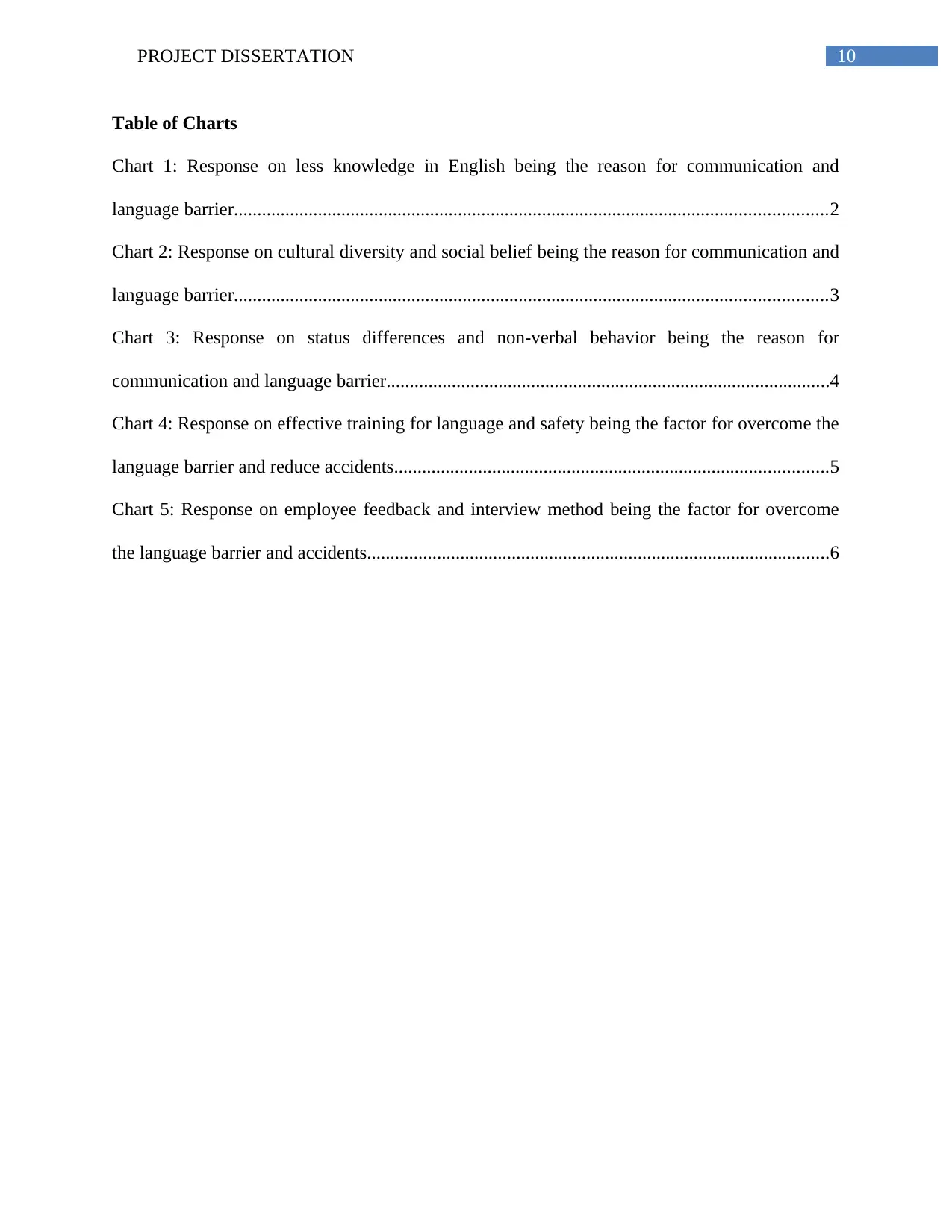
10PROJECT DISSERTATION
Table of Charts
Chart 1: Response on less knowledge in English being the reason for communication and
language barrier...............................................................................................................................2
Chart 2: Response on cultural diversity and social belief being the reason for communication and
language barrier...............................................................................................................................3
Chart 3: Response on status differences and non-verbal behavior being the reason for
communication and language barrier...............................................................................................4
Chart 4: Response on effective training for language and safety being the factor for overcome the
language barrier and reduce accidents.............................................................................................5
Chart 5: Response on employee feedback and interview method being the factor for overcome
the language barrier and accidents...................................................................................................6
Table of Charts
Chart 1: Response on less knowledge in English being the reason for communication and
language barrier...............................................................................................................................2
Chart 2: Response on cultural diversity and social belief being the reason for communication and
language barrier...............................................................................................................................3
Chart 3: Response on status differences and non-verbal behavior being the reason for
communication and language barrier...............................................................................................4
Chart 4: Response on effective training for language and safety being the factor for overcome the
language barrier and reduce accidents.............................................................................................5
Chart 5: Response on employee feedback and interview method being the factor for overcome
the language barrier and accidents...................................................................................................6
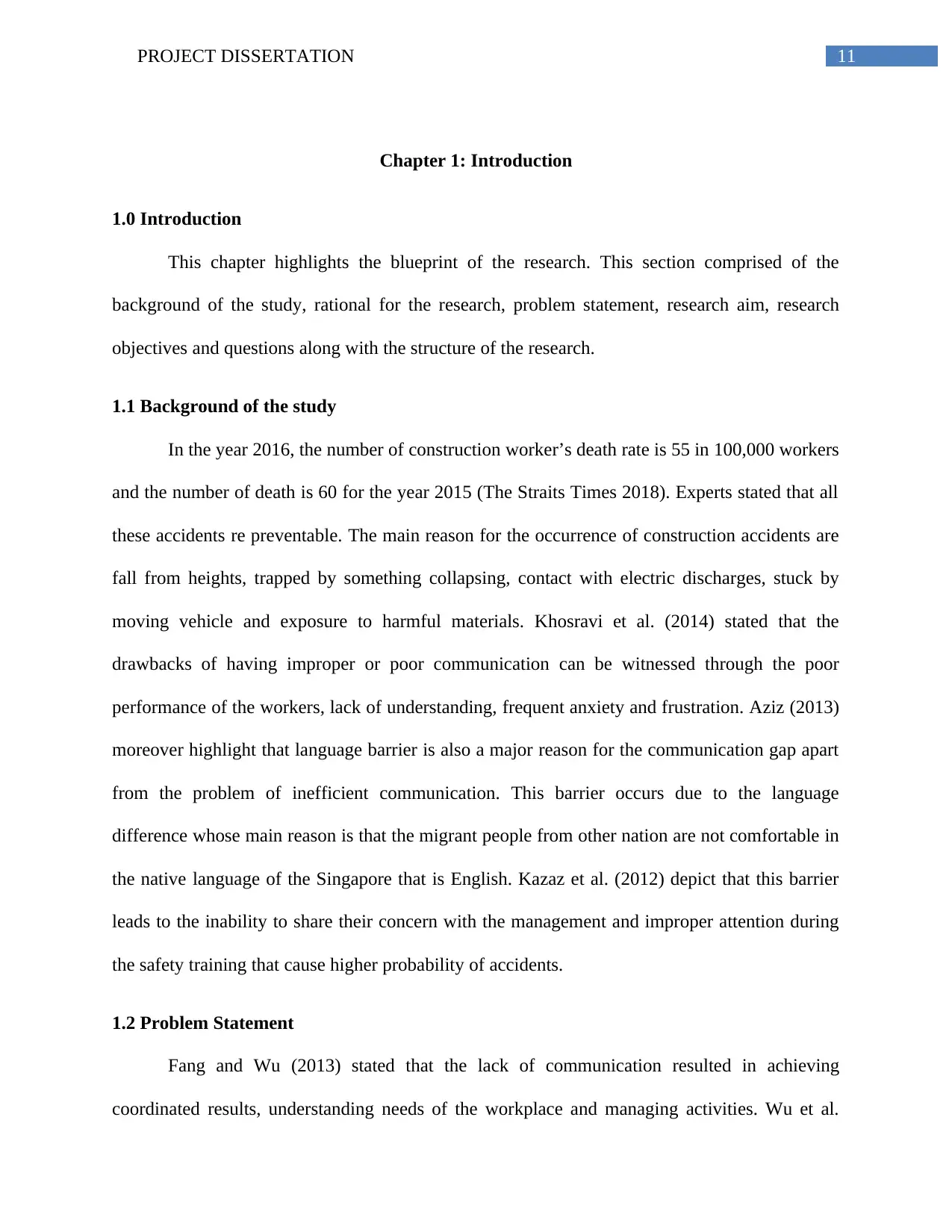
11PROJECT DISSERTATION
Chapter 1: Introduction
1.0 Introduction
This chapter highlights the blueprint of the research. This section comprised of the
background of the study, rational for the research, problem statement, research aim, research
objectives and questions along with the structure of the research.
1.1 Background of the study
In the year 2016, the number of construction worker’s death rate is 55 in 100,000 workers
and the number of death is 60 for the year 2015 (The Straits Times 2018). Experts stated that all
these accidents re preventable. The main reason for the occurrence of construction accidents are
fall from heights, trapped by something collapsing, contact with electric discharges, stuck by
moving vehicle and exposure to harmful materials. Khosravi et al. (2014) stated that the
drawbacks of having improper or poor communication can be witnessed through the poor
performance of the workers, lack of understanding, frequent anxiety and frustration. Aziz (2013)
moreover highlight that language barrier is also a major reason for the communication gap apart
from the problem of inefficient communication. This barrier occurs due to the language
difference whose main reason is that the migrant people from other nation are not comfortable in
the native language of the Singapore that is English. Kazaz et al. (2012) depict that this barrier
leads to the inability to share their concern with the management and improper attention during
the safety training that cause higher probability of accidents.
1.2 Problem Statement
Fang and Wu (2013) stated that the lack of communication resulted in achieving
coordinated results, understanding needs of the workplace and managing activities. Wu et al.
Chapter 1: Introduction
1.0 Introduction
This chapter highlights the blueprint of the research. This section comprised of the
background of the study, rational for the research, problem statement, research aim, research
objectives and questions along with the structure of the research.
1.1 Background of the study
In the year 2016, the number of construction worker’s death rate is 55 in 100,000 workers
and the number of death is 60 for the year 2015 (The Straits Times 2018). Experts stated that all
these accidents re preventable. The main reason for the occurrence of construction accidents are
fall from heights, trapped by something collapsing, contact with electric discharges, stuck by
moving vehicle and exposure to harmful materials. Khosravi et al. (2014) stated that the
drawbacks of having improper or poor communication can be witnessed through the poor
performance of the workers, lack of understanding, frequent anxiety and frustration. Aziz (2013)
moreover highlight that language barrier is also a major reason for the communication gap apart
from the problem of inefficient communication. This barrier occurs due to the language
difference whose main reason is that the migrant people from other nation are not comfortable in
the native language of the Singapore that is English. Kazaz et al. (2012) depict that this barrier
leads to the inability to share their concern with the management and improper attention during
the safety training that cause higher probability of accidents.
1.2 Problem Statement
Fang and Wu (2013) stated that the lack of communication resulted in achieving
coordinated results, understanding needs of the workplace and managing activities. Wu et al.
⊘ This is a preview!⊘
Do you want full access?
Subscribe today to unlock all pages.

Trusted by 1+ million students worldwide
1 out of 63
Related Documents
Your All-in-One AI-Powered Toolkit for Academic Success.
+13062052269
info@desklib.com
Available 24*7 on WhatsApp / Email
![[object Object]](/_next/static/media/star-bottom.7253800d.svg)
Unlock your academic potential
Copyright © 2020–2025 A2Z Services. All Rights Reserved. Developed and managed by ZUCOL.





